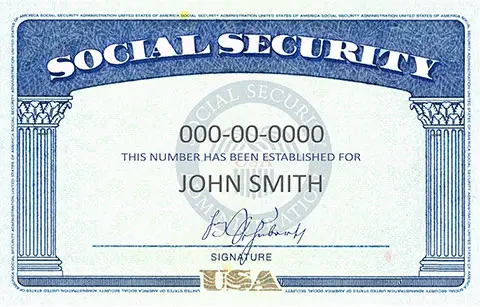
Even if you are not nearing retirement age, you have likely heard about Social Security in the news. While millions of Americans receive Social Security benefits each month, many people do not know how the system works. You might wonder how you qualify for benefits, when you can receive benefits, or how much your benefit payments might be. There are also several different types of benefits for which you might be eligible. We will give you all the details about Social Security, including how the system works, the history of the program, and potential changes that you could see in the future.
How Does Social Security Work?

When most people think of Social Security, they immediately think about its retirement benefits. The Social Security Administration (SSA) issues benefit payments each month to retirees, and Social Security is the largest line item in the Federal budget. Here is how the system works.
If you have looked at your paystub recently, you might have noticed that Social Security taxes are withheld from each of your paychecks. You might also see a tax called the OASDI tax, or Old-Age, Survivors, and Disability Insurance tax. You are required to pay 6.2% of your gross earnings into the Social Security program, and your employer also pays a matching amount of tax. For those who are self-employed, you will be required to pay the total 12.4% tax on your own.
These taxes are placed into the Social Security trust funds, and money from those funds is used to pay benefits each month. The taxes that you pay are not placed into your own personal retirement account. Instead, those taxes are used to pay benefits to current beneficiaries. Upon your retirement, your benefits will be paid by the taxes collected from people currently working and paying taxes.
To qualify for retirement benefits, you must earn at least the minimum number of work credits. In most cases, this means that you must work for at least ten years. However, to maximize your Social Security payments, you need to work for at least 35 years. Your benefit amount is calculated using your highest 35 years’ worth of earnings, and your retirement age. We will discuss the specific calculation later in this article.
In addition to retirement benefits, you might also be able to qualify for spousal benefits, survivor benefits, or disability benefits. Each of these benefit types has different eligibility criteria, and we will discuss each one in more detail later in this article.
The History Of Social Security

So, what is Social Security, and how did it start? The Social Security program started in 1935 when President Franklin D. Roosevelt signed the Social Security Act into law. The law allowed Social Security taxes to be collected, and the first monthly benefit payments were scheduled to start in 1942. Initially, Social Security provided payments only to retirees aged 65 and older. This program provided financial assistance for retirees, although Social Security was missing some major items during its early years. For instance, there was no disability insurance coverage or Medicare benefits at that time.
In the 1950s, amendments to the Social Security Act enabled cost-of-living adjustments for beneficiaries and disability benefits. These were some of the first major changes to the Social Security program, which aimed to make it a more comprehensive program. In the 1960s, Medicare was introduced. Since most people relied on an employer-sponsored health insurance plan, most retirees had no medical insurance coverage. For this reason, Medicare was born.
In the 1970s, the Social Security Administration took on responsibility for Supplemental Security Income (SSI) benefits. This program was designed to consolidate several other programs into one and provide benefits for blind, aged, disabled, and needy adults. Changes continue to be made to Social Security, and more changes are likely in the future. We will discuss those potential changes later in this article.
Social Security Taxes And The Tax Limit
We have already mentioned that the Social Security tax rate is 6.2% of your earnings. We also discussed the fact that your employer must match this tax. However, there is a limit to the amount of tax that will be due in one year. In 2023, the Social Security earnings limit is $160,200. This means that you will only owe taxes on your first $160,200 in earnings. If you earn more than this limit, no Social Security tax will be due on the excess earnings.
The Social Security tax limit changes almost every year. Most of the time, the tax limit is adjusted at about the same rate as the COLA increase for benefits. For example, in 2022, the tax limit was $147,000. The increase in 2023 is roughly a 9% increase from 2022. This increase nearly matches the 8.7% COLA increase that took effect in 2023.
In some cases, you might pay more Social Security taxes than the limit requires. This is common when you work more than one job and your combined earnings exceed the limit. In that case, you will receive a refund for the excess tax you have paid. When you file your income taxes for the year, you will receive the overage as part of your tax refund.
Types Of Social Security Benefits

There are several types of benefits available from the Social Security Administration, and here are a few details about some of the most common types. The type of benefit for which you may qualify will depend on your specific situation, like your work history, age, and spouse’s work history.
Retirement Benefits
Retirement benefits are the most common benefit paid by the Social Security Administration. These benefits are paid each month to millions of retirees across the country. The amount you receive each month depends on how much money you earn while working; thus, it depends on how much you pay in Social Security tax. You must typically have worked at least ten years to receive these benefits, and you can start receiving them as early as age 62. However, waiting until later to start your benefits will result in a higher monthly payment. These benefits are paid for life, so once you start receiving them, you will receive a monthly payment for the rest of your life. You may be interested in our article about how to apply for social security benefits.
Spousal Benefits
Even if you don’t have your own work history, you might still be able to receive benefits from the Social Security Administration based on your spouse’s work record. In most cases, your spousal benefit will be 50% of the primary beneficiary’s benefit amount. So, you could still receive a significant monthly benefit from Social Security even without a work history. Even if you qualify for your own benefit, you may receive the spousal benefit if that amount is higher than your own benefit. You cannot receive both your own benefit and a spousal benefit at the same time. You should also be aware that ex-spouses may qualify for a spousal benefit. You might also be interested in our article about when a spouse can claim spousal benefits.
Disability Benefits
If you become disabled and unable to work before you reach retirement age, you may qualify for disability benefits from the Social Security Administration. To qualify for Social Security disability insurance (SSDI) benefits, you must have a sufficient work history. The process of getting approved for disability can often take quite some time. Some applications take more than a year to get approved, especially if an appeal is needed. Those who receive disability benefits for 24 months will also be automatically enrolled in Medicare. Here is an article about how to apply for disability.
Survivor Benefits
A spouse or dependent child of a Social Security beneficiary can be eligible for survivor benefits. This benefit can be as much as 100% of the deceased spouse’s benefit amount. If you were already receiving spousal benefits at the time of your spouse’s death, you should notify the Social Security Administration immediately. You can be switched from spousal benefits to survivor benefits, but the increase in benefit payments is not retroactive. The longer you wait to notify the SSA of the death, the more money you will lose in benefits. In the case of the death of an ex-spouse, you may also qualify for survivor benefits.
Here is more information about how Social Security Survivor benefits for spouses work.
Applying For Social Security Benefits & The Full Retirement Age

So, when can you start receiving Social Security benefits? While there are a few limited exceptions that allow you to start your benefits sooner, most people may start their benefits as early as age 62. However, there is a major caveat to that statement. Starting your benefits at 62 will lead to a reduction in your monthly benefit amount. Waiting until you reach full retirement age (66 or 67 for most people) will allow you to receive 100% of your primary insurance amount. Starting your benefits early will lead to a reduction of about 0.5% per month; therefore, starting your benefits at age 62 will lead to a 30% reduction in your payments.
On the other end of the spectrum, waiting past your full Social Security age can lead to an increase in your payments. Delaying the start of your benefits will allow you to accrue delayed retirement credits. This means that you will see roughly a 0.5% increase in your benefit amount each month that you wait past your full retirement age. Delayed retirement credits will max out at age 70, so there is no reason to wait past 70 to begin your benefits.
To find out the implications of retiring at different ages, you can use our Social Security Break Even Calculator. You will need to know an estimate of your full retirement age benefit. Details of how to calculate this can be found in the next section.
Calculating Your Social Security Benefit Amount
So, how much will your Social Security payments be when you start receiving benefits? The answer depends on several factors, like your lifetime earnings and retirement age. Social Security uses a formula to calculate your benefit amount. You can perform the Social Security benefit calculation on your own, although it can get a little complicated. You can also create a My Social Security account at www.SSA.gov and use the benefit estimator tool to estimate your benefit amount.
How the calculation works
First, you will need to index each year of your earnings record to the current year’s values. To do this, you should use the indexing values provided by the Social Security Administration. This helps account for inflation in the calculation. For example, if you earned $50,000 in 2010, that value might need to be adjusted to $55,000 in today’s economy. Once you have indexed your earnings, you will add the highest 35 years’ worth of earnings and divide by 420. This will give you your average indexed monthly earnings (AIME). If you have fewer than 35 years in your earnings history, you will need to use zeros for any missing years.
Once you have your AIME, you must apply the Social Security bend points to calculate your primary insurance amount. In 2023, here is how the bend points work: You will need to find the sum of 90% of your first $1,115 in earnings plus 32% of earnings between $1,115 and $6,721 plus 15% of any earnings over $6,721. This sum will be your primary insurance amount. This will be your benefit if you start your benefits at full retirement age (FRA).
To get your specific benefit amount, you will need to adjust your primary insurance amount for your retirement age. Retiring early will lead to a reduction in benefits, while waiting until later to retire will increase your payments. Also, remember that Social Security provides an automatic cost-of-living adjustment each year. The annual COLA uses the consumer price index to determine the amount of inflation for the year, and your benefit payments are increased by that amount. In years where there is negative inflation, you will see no change to your benefits.
Are Social Security Benefits Taxable?
Since Social Security is one of the main sources of retirement income for many people, you are likely wondering whether your Social Security benefits are taxable. The answer depends on your overall income for the year. Your benefits might not be taxable, or you might find that up to 85% of your benefits are taxable. The final 15% of your Social Security benefits will never be taxable.
First, you need to calculate what Social Security calls your “combined income.” This includes your adjusted gross income, tax-exempt interest, and half of your Social Security benefits. If your combined income is less than $25,000, your benefits will not be taxed. If your combined income is between $25,000 and $34,000, then half of your benefits will be taxed. Finally, if your combined income is more than $34,000, you will owe taxes on 85% of your benefits. These numbers are adjusted slightly higher for married couples filing a joint tax return. Here is a comprehensive article about how much you can earn while receiving social security benefits.
Medicare Coverage With Social Security Benefits
The Federal Government recognized the need for health insurance coverage for retirees since most people are covered under an employer-sponsored plan. Upon retirement, most people have no good options for insurance. Thus, the Medicare program was born. Medicare provides medical insurance benefits for people aged 65 and older or younger people with disabilities. Medicare should not be confused with Medicaid. Medicaid is an entirely separate program for low-income individuals and families.
If you are already receiving Social Security benefits when you turn 65, you will be automatically enrolled in Medicare coverage. For those not already receiving Social Security, you will need to apply for Medicare benefits. As long as you have a sufficient work history, you will qualify for premium-free Part A coverage. However, you will need to pay a monthly premium for your Medicare Part B coverage. Original Medicare provides both hospital insurance and traditional medical insurance for doctor’s visits and other health care services.
Many people choose to sign up for a Medicare Advantage plan instead of Original Medicare. Private insurance companies manage these plans. Advantage plans must provide at least the same minimum level of coverage as provided by Original Medicare, although many of these plans provide additional benefits. You might find that these plans include dental and vision coverage, prescription drug coverage, gym memberships, and other benefits.
The Future Of Social Security
The future of Social Security has been a hot topic in the news in recent years. Most U.S. citizens realize that the Social Security program cannot continue to operate in the same manner for much longer. Within the last couple of years, the program has begun to pay more benefits than it collects in Social Security taxes. This is beginning to deplete the Social Security trust funds, so something clearly must be done. There is a lot of debate over what the fix looks like, though.
While no one knows exactly what the future of Social Security holds, there are a few things that are discussed most often. First, raising the Social Security tax is one option on the table. Collecting more taxes would allow the program to pay full benefits without dipping into its reserves to cover costs. Instead of raising the tax rate, another proposal is to raise or eliminate the tax limit. Raising the limit would mean that you would pay Social Security taxes on all of your earnings and not just the first $160,200.
Other options that have been discussed are lowering Social Security benefits or raising the full retirement age. These options are much less desirable, as it is already difficult to survive on Social Security benefits alone. Likewise, the retirement age was raised just a few years ago, so most people do not want these changes to be implemented. The most likely scenario seems to involve raising the tax rate or limit.
Social Security has enough money to pay full benefits through 2034; however, the program will only have enough money to pay roughly 80% of its obligations after that. So, you can see that changes need to be made relatively quickly. We will just have to wait and see which changes ultimately get implemented.
The Bottom Line
Whether you receive a Social Security check or not, you need to understand how the Social Security system works. You should now know the program’s history and how your benefits are calculated. If you are wondering how to get Social Security, you now know that you must have paid Social Security taxes for at least ten years to qualify. High earners will get a bigger Social Security check than lower earners because they paid more Social Security taxes during their working years.
Your benefits could be taxable, depending on your total income for the year. Finally, you should know that changes will be necessary to the Social Security program soon. The program is projected to have exhausted its reserve funds in 2034, and it will not have enough money at that time to pay all its obligations. While no one knows what changes will ultimately occur, you should pay close attention to see how the changes might affect your retirement plans.
Frequently Asked Questions
What is the difference between Social Security and SSI?
Social Security benefits are only available to those with a work history and who have paid Social Security taxes. However, SSI benefits are designed to help low-income individuals and family members, even if they do not have an earnings record. SSI benefits are available to those 65 and older, blind individuals, or younger individuals with disabilities. SSI benefits are typically much lower than Social Security benefits, although participation in the SSI program might also qualify you for other assistance programs, like housing assistance, food stamps, and others.
How many years do you have to work to get the maximum Social Security benefit?
To get the maximum Social Security benefit, you must work for at least 35 years. If you work less than this, you will have a zero for some years in your benefit calculation. In addition to working 35 years, you must earn at least the Social Security tax limit in each of these years to receive the maximum Social Security payment upon retirement.
What is the average Social Security benefit?
The average retiree receives $1,676 per month from Social Security. As you can see, this is not a huge payment. It is much less than the maximum Social Security payment of $4,194. Many people even receive less than the average retirement benefit. For this reason, it is imperative that you save for your own retirement and do not rely wholly on Social Security. Other retirement accounts, like an annuity, IRA, or 401k, are crucial to your financial stability during retirement.
Do you get Social Security if you never worked?
No, you cannot qualify for your own Social Security benefits if you never worked. However, there is one exception to receiving benefits without a work history. If your spouse or ex-spouse qualifies for Social Security, you can receive a spousal benefit based on their work record. Typically, spousal benefits equal 50% of the primary beneficiary’s payment amount. So, there is a way to receive Social Security even if you never worked. Surviving spouses can also switch to a survivor benefit upon the death of the primary beneficiary.
When do you start getting Social Security?
For most people, the full retirement age for Social Security is 66 or 67. However, you can start receiving your benefits as early as age 62. Starting your benefits this early will lead to roughly a 30% reduction in your benefit payments. For some people, it makes sense to start their benefits early even though their payments are reduced. You should consider your overall health, life expectancy, financial situation, other sources of income, and a few other factors when deciding when to start your benefit payouts.
